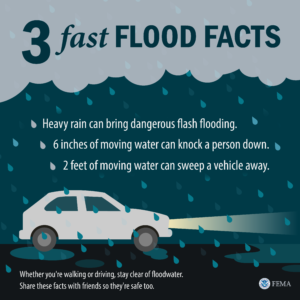Floods are the most frequent and costly natural disasters. Make sure your family knows what to do before, during and after a flood to increase their chances of survival.
Know the Difference
Flood/Flash Flood WATCH
Flooding or flash flooding is possible.
Flood/Flash Flood WARNING
Flooding or flash flooding is imminent or occurring.
Be Prepared
These tasks can be done now. If a weather disaster occurs, you may have to evacuate at a moment’s notice.
- Know your area’s flood risk. Visit FEMA’s Flood Map Service Center.
- Make an emergency supply kit.
- Register with WarnCentralTexas to receive emergency alerts.
- Be able to identify your neighborhood on a map.
- Take photos of your home and its contents.
- Keep important documents in a waterproof container. Save digital copies.
- Make a plan for evacuating your family and pets.
- Obtain flood insurance under the National Flood Insurance Program (NFIP). Homeowner’s policies do not cover flooding.
If a Flood is Likely
- Fill your car’s gas tank.
- Charge devices.
- Have your emergency supply kit handy.
- Bring outdoor furniture and other unsecured items inside.
- Fill plastic bottles with water for drinking.
- Fill sinks and the bathtub with water for flushing toilets and cleaning.
- If directed to do so by local authorities, turn off utilities. (If you turn off your gas, a professional must turn it back on)
- If you have time, move furniture and valuables to an upper floor.
- Unplug small appliances.
- Keep pets indoors and under your direct control. Take them with you if you evacuate.
-
If you have livestock, move animals to high ground or evacuate them to a safe place.
During a Flood
- Listen to authorities for information and instructions.
- If told to evacuate, do so immediately.
- Take your emergency supply kit.
- Do not walk, swim, or drive through flood waters. Turn Around. Don’t Drown!
- Do not cross a bridge with water flowing over it.
- Stay off bridges over fast-moving water. Fast-moving water can wash bridges away.
- If your vehicle is trapped in rapidly moving water, stay inside. If water is rising inside the vehicle, then seek refuge on the roof.
- If trapped in a building, go to its highest level. Do not climb into a closed attic. You may become trapped by rising floodwater. Go on the roof only if necessary.
Floodwater can contain dangerous debris and contamination and be electrically charged by underground or downed power lines.
After a Flood
- Return home only when officials have declared it safe.
- Keep children and pets away from floodwater.
- Wear protective clothing (long sleeves, pants, rubber gloves, mask) during clean up. Snakes and other animals may be in your house.
- Do not touch electrical equipment if it is wet or if you are standing in water.
- Do not use potentially contaminated water to cook, wash, drink, brush teeth, prepare food, or make ice.
- Toss food, beverages, and medicine that came into contact with floodwater, including canned food and items in sealed containers.
- Do not turn on any appliances (gas or electric) that have been flooded.
- Avoid downed power lines and report them to the power company immediately.
- Take photos of any damage to your home and its contents; you will need these for insurance purposes.
- Throw away any items that absorb water and cannot be cleaned or disinfected.



